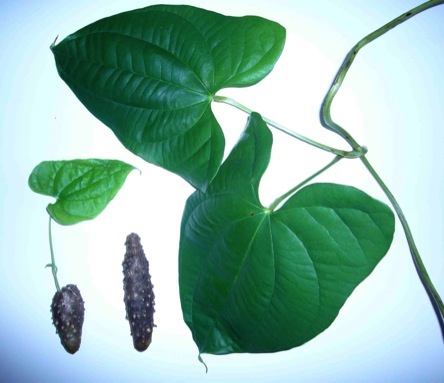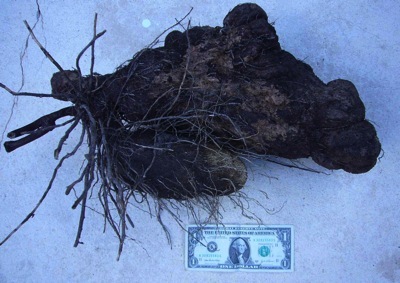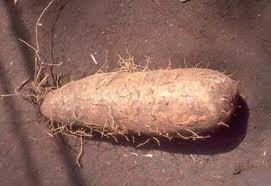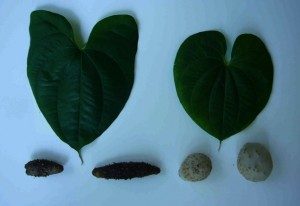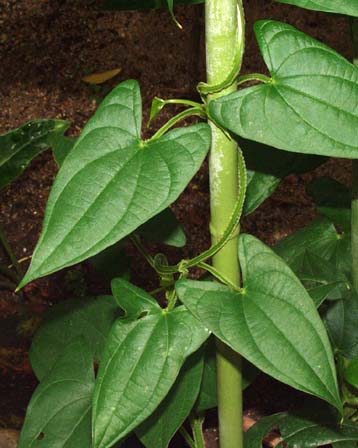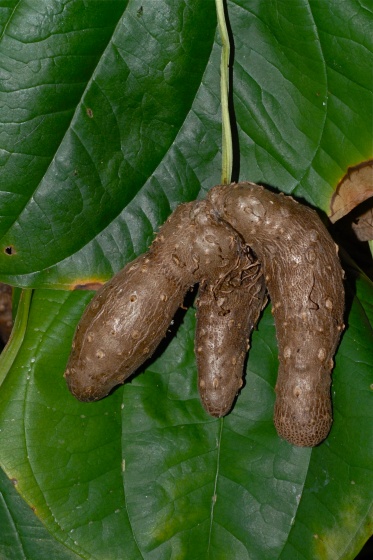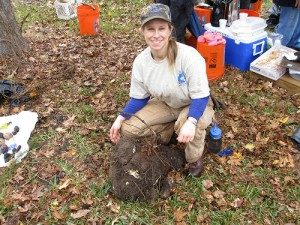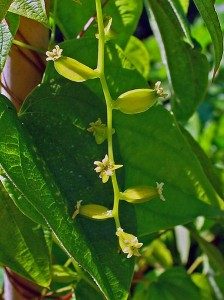The Dioscorea Dilemma: Which ones are edible, and what parts?
One wouldn’t think wild yams would be hard to sort out. It only took me about a dozen years.
I’m not talking about anything related to the sweet potato. That’s the Ipomoea family. I’m talking about real yams, in the Dioscorea family. Like many imported plants into warm climates, the Dioscorea (Dye-os-KOH-ree-uh or in Greek thee-oh-skor-REE-uh) have become an invasive weed. And as you know, the motto here is eat the weeds. Let’s see if we can sort them out. There are three escaped yams locally. I call them Yam A, Yam B and Yam C.
The most common yam in the South is, unfortunately, probably the least edible, Yam B, the Dioscorea bulbifera — B for bulbifera (bul-BIFF-er-ra.) It was first sent to Orlando in 1905 as a possible ornamental and food crop. The fellow who got the D. bulbifera concluded it was dangerous to Florida but didn’t eradicate while he had the chance. It has since escaped and become a scourge of the countryside. I have not personally proven its edibility. I have a separate article elsewhere on this site called “Yam B: The Bulbifera.” Yam C is the Chinese Yam or the Cinnamon vine yam. It’s botanical name is Dioscorea polystachya (mistakenly called D. oppositifolia.) It is covered in a different article as well. Yam C: The Chinese. This article is about Yam A, Dioscorea Alata — A for Alata uh-LAY-tuh. It is also called the Winged Yam because its stem is very square.
Yam A, or the winged yam, is also called the “water Yam” the “great yam” the “lesser yam,” and the “purple yam” among others. It’s not born free anywhere in the world but is a product of cultivation that has escaped into the wild. Researchers think it was an intentional hybridizing of two wild yams by man some 8,000 years ago. So while Yam A, the D. alata, is found in the wild, it is not a wild yam.
Under cultivation, varieties of D. alata are the most common yam in the world. It has an underground root that can grow upwards of 7.5 feet long and a 136 pounds (the known record is 180 pounds.) When cultivated it can grow long and uniform. In hard soil, or in old age, it can be lumpy and malformed. Young roots tend to be solid and straight, older roots tend to branch out. Boiling (or roasting) of the root makes it edible. It got to Africa from Asia around 1,500 B.C. and probably came to the Americas with slaves by the 1700s. By the 1950s D. alata was the most common Yam in the state. The D. bulbifera did not take over for a few more decades.
At first glance Yam A, the D. alta, and Yam B, the D. bulbefera, look quite alike but they have several differences. D. alata’s leaf is an arrow-shaped heart (think arrow-Alata) D. bulfiera is a ball-shaped heart (think ball-bulifera). The D. alata leaves grow in pairs particularly near the growing end of the vine where as young D. alatas can have one leaf instead of leaves in pairs, the D. bulbifera singly. The D. alata has a large, very square stem with edges tinged in purple, the D. bulbifera has a slight round green stem. The D. alata has bulbils that are dark brown with a variety of shapes, the D. bulbifera has bulbils that are lumpy round and tan (from Asia I think) or round and brown with tan pimples (from Africa I think). Incidentally, D. alata bulbils soaked 4 hours in water germinate three weeks faster than non-soaked bulbils.
The D. alata, when climbing at eye level, twists from your lower left across the surface nearest you to your upper right, the so-called Z-twist. The D. bulbifera twists from your lower right across the surface nearest you to your upper left, the S-twist. I am beginning to think the way of the twist is the first sign of a prime edible yam. Ignore books that say a vine twists clockwise or counter clockwise if they don’t provide you the perspective of the viewer. Depending whether you are looking down or up the same twist can be called clockwise or counter clockwise. If you are looking down at a D. alata it looks to go counter clockwise. If you’re looking up at the D. alata it appears to go clockwise. I have two books that describe its twist in different directions because of the perspective.
Once you learn to tell the differences the D. alata (as well as Yam C, the Chinese Yam) are fairly easy to spot among their prolific relative, the D. bulbifera. Yam A and Yam C (the Chinese Yam) leaves give them away even at a distance since they grow in pairs. The D. bulbifera has alternating single leaves so from a distance if you see single leaves like a series of steps in a stairs you know it’s not the one you want. As for availability… along one bike trail I traverse, for one mile all the trees are draped with Yam B. But, there are three patches of Yam A. Yam C is in very isolated pockets.
While the D. Alta has a reputation for being buried very deep that has not been my experience. I usually find the large root within a few inches of the surface. When grown in soft soil the D. alata is long and tubular, when growing in hard soil it will be lumpy and distorted. Old roots can also be lumpy and banched. The largest I have found to date is 8.2 pounds after washing, and that is the norm. Young roots are best used like potatoes, older roots while edible have a different texture, can be fried after boiling or make a good flour. The vine usually puts on one tuber per season but can produce as many as three. Thus the older root can be lumpy but have a younger, well-formed root attached, as the top picture shows.
When under cultivation the D. alata is usually left to cure for a week after it is dug up, but that’s not necessary, and it will store for several months. The vine also go into a dormant period. Here in Florida that is about Christmas to St. Patrick’s Day. During that time the vines die back. If you want to dig them up during that time you should mark them earlier in the season. The U.S. Department of Agriculture reports the bulbils of the D. alata are edible cooked but not as palatable as the roots, and my friend, Maribou, has tried them. I, personally, have not gotten around to eating them. It’s on my list of plant things to do.
Dioscorea was named after Pedianos Dioscorides, Greek physician of the first century AD whose book on medicinal herbs Materia Medica, was a standard work until recent times. Alata means winged. Bulbifera means bearing bulbs. Polystachya, many stakes, or blossom spikes.
For the record, among the semi-edibles yams one might see are: Dioscorea villosa, (vill-LOE-suh) whose roots might be a famine food but with a price. This was the yam from which the first birth control pills were made. There has been some speculation that the Mayans suffered a loss of their maize crop and had to eat D. villosa, causing a fertility drop in their population they could not recover from. (It twines lower right to upper left, the S-twist.) There are also native Florida yams, but they are rare and have no “bulbils” Dioscorea floridana and Dioscorea quarternata. The native plants are only infrequently seen in north and west Florida hammocks and flood plains. Villosa means shaggy; floridana, Florida; quarternata, four leaves from one place; polystachya many spikes. The word “yam” comes from a west African language and means “something to eat.”
Approximate yam nutrition per 100g: 103 calories; sugars (g) 23; Proteíns (g) 1; Fiber (g) 4; Vitamin B1 (mg) 112; Vitamin B2 (mg) 32; Vitamin C (mg) 17; Salt (mg) 9; Potássium (mg) 816; Cálcium (mg) 17; Phosphorus (mg) 55. It does not have any iron, fat, vitamin A, and no vitamin B3.
Green Deane’s Itemized” Plant Profile
IDENTIFICATION: Dioscorea alata: Winged Yam. Large arrow-shaped leaves, opposite, stem with four definite sides, edges of the sides often tinged in purple. Stem climbs from lower left to upper right. Bulbils dark brown, round or cylinder, lumpy, mishapen. Underground root similar to a sweet potato in shape when grown is soft soil, lumpy and distorted when grown in hard soil. Can be up to 136 pounds.
TIME OF YEAR: Fall, September to December. For two months the vine dies back making locating difficult.
ENVIRONMENT: Yams do well in sun or partial shade and prosper with ample rainfall. They require good drainage, and therefore, are often planted on mounds or ridges.
METHOD OF PREPARATION: Underground roots only: Usually fresh young yam is peeled, cut up and boiled like a potato. Older yams can be pounded into a sticky elastic dough called pounded yam or yam fufu. To make a flour from the D. Alata root slice the underground tubers to a thickness of about quarter inch. Parboil the peeled slices. Dried them in the sun to reduce the moisture content. The dried slices are then ground to flour and sieved to make a uniform texture. Otherwise, the boiled yam can also be used like potatoes. IF ANY YAM TASTES BITTER, DON’T EAT IT.

